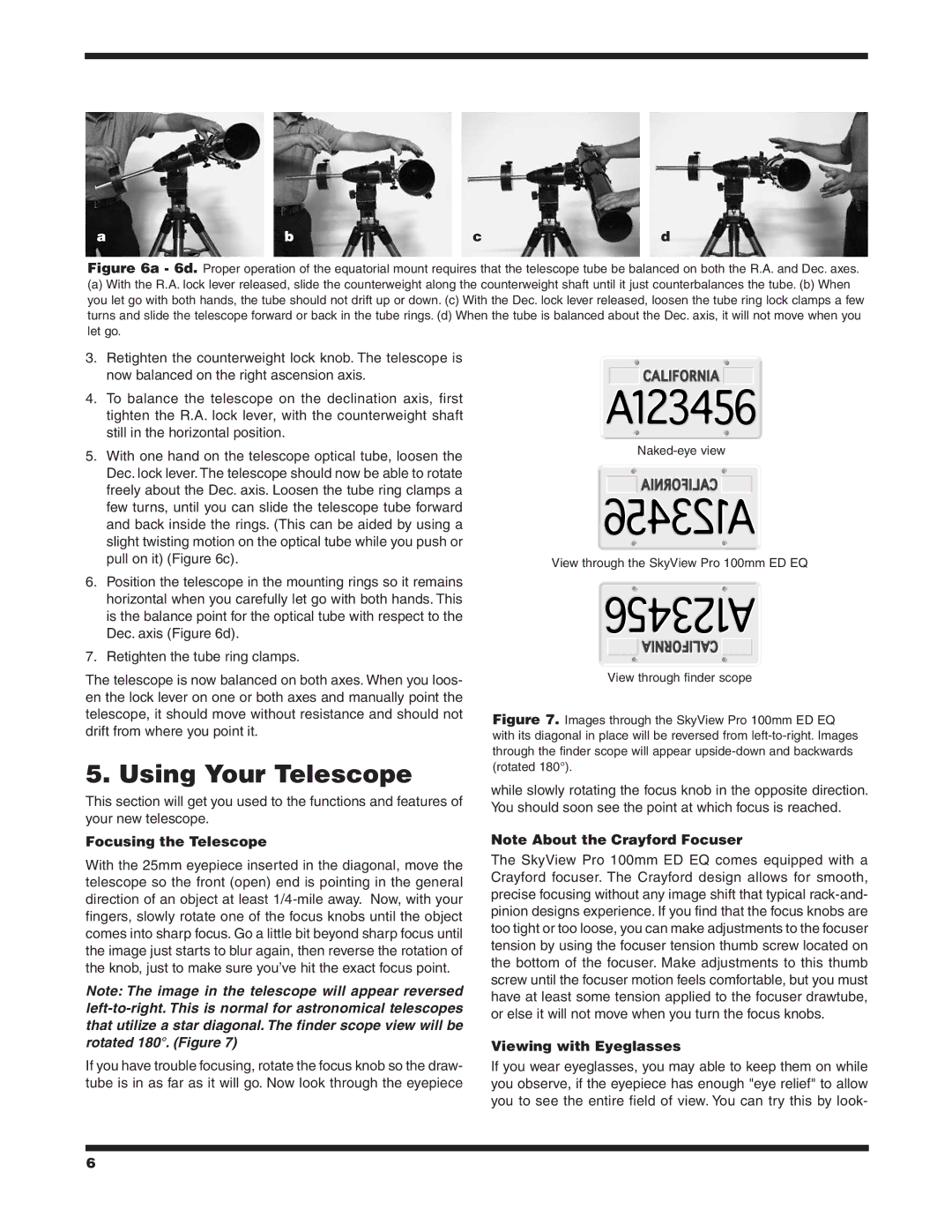
a | b | c | d |
Figure 6a - 6d. Proper operation of the equatorial mount requires that the telescope tube be balanced on both the R.A. and Dec. axes.
(a)With the R.A. lock lever released, slide the counterweight along the counterweight shaft until it just counterbalances the tube. (b) When you let go with both hands, the tube should not drift up or down. (c) With the Dec. lock lever released, loosen the tube ring lock clamps a few turns and slide the telescope forward or back in the tube rings. (d) When the tube is balanced about the Dec. axis, it will not move when you let go.
3.Retighten the counterweight lock knob. The telescope is now balanced on the right ascension axis.
4.To balance the telescope on the declination axis, first tighten the R.A. lock lever, with the counterweight shaft still in the horizontal position.
5.With one hand on the telescope optical tube, loosen the Dec. lock lever. The telescope should now be able to rotate freely about the Dec. axis. Loosen the tube ring clamps a few turns, until you can slide the telescope tube forward and back inside the rings. (This can be aided by using a slight twisting motion on the optical tube while you push or pull on it) (Figure 6c).
6.Position the telescope in the mounting rings so it remains horizontal when you carefully let go with both hands. This is the balance point for the optical tube with respect to the Dec. axis (Figure 6d).
7.Retighten the tube ring clamps.
The telescope is now balanced on both axes. When you loos- en the lock lever on one or both axes and manually point the telescope, it should move without resistance and should not drift from where you point it.
5. Using Your Telescope
This section will get you used to the functions and features of your new telescope.
Focusing the Telescope
With the 25mm eyepiece inserted in the diagonal, move the telescope so the front (open) end is pointing in the general direction of an object at least
Note: The image in the telescope will appear reversed
If you have trouble focusing, rotate the focus knob so the draw- tube is in as far as it will go. Now look through the eyepiece
View through the SkyView Pro 100mm ED EQ
View through finder scope
Figure 7. Images through the SkyView Pro 100mm ED EQ with its diagonal in place will be reversed from left-to-right. Images through the finder scope will appear upside-down and backwards (rotated 180°).
while slowly rotating the focus knob in the opposite direction. You should soon see the point at which focus is reached.
Note About the Crayford Focuser
The SkyView Pro 100mm ED EQ comes equipped with a Crayford focuser. The Crayford design allows for smooth, precise focusing without any image shift that typical rack-and- pinion designs experience. If you find that the focus knobs are too tight or too loose, you can make adjustments to the focuser tension by using the focuser tension thumb screw located on the bottom of the focuser. Make adjustments to this thumb screw until the focuser motion feels comfortable, but you must have at least some tension applied to the focuser drawtube, or else it will not move when you turn the focus knobs.
Viewing with Eyeglasses
If you wear eyeglasses, you may able to keep them on while you observe, if the eyepiece has enough "eye relief" to allow you to see the entire field of view. You can try this by look-
6
